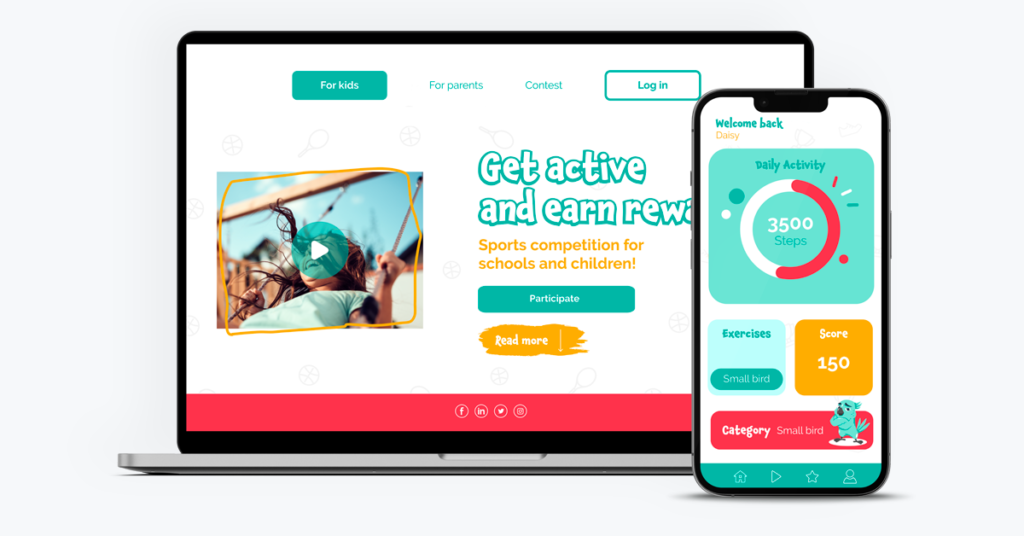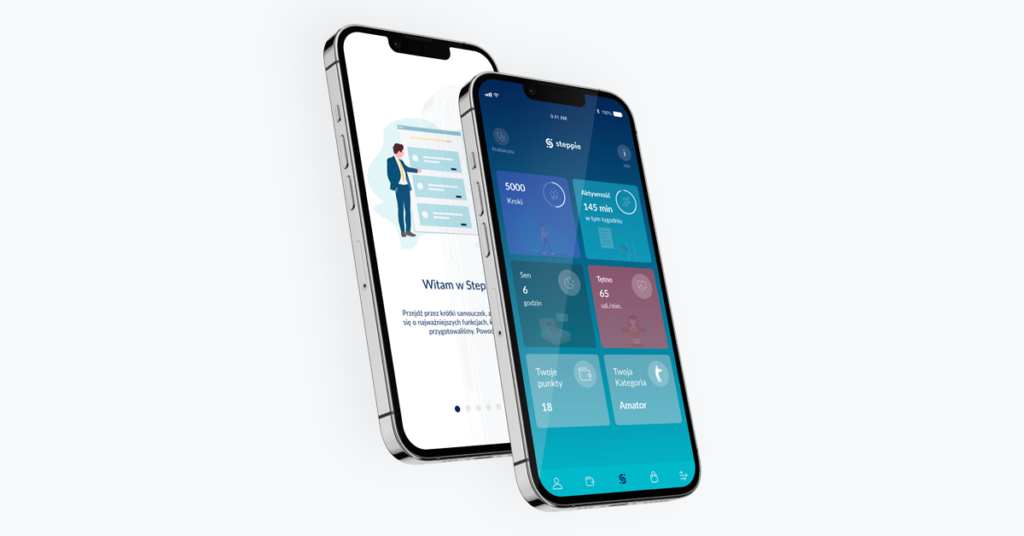How to turn mundane tasks into exciting challenges, just like in a video game? Gamification does precisely that. In simple terms, it’s the application of game elements – like points, levels, and rewards – in non-game contexts. The idea is to make activities more engaging and fun, motivating users to keep coming back.
Now, let’s talk about healthcare. We’ve all heard the saying, “Prevention is better than cure.” But getting patients actively involved in their health journey is often easier said than done. That’s where HealthTech comes in, using technology to boost patient engagement. When engaged, patients are more likely to follow medical advice, understand their conditions, and actively participate in their recovery. And guess what? Adding a touch of gamification to HealthTech can strengthen this engagement, turning health routines into engaging challenges patients are eager to take on. It’s a win-win for both health professionals and those they care for.

The Link Between Gamification Use and Engagement
Have you ever wondered why gaming, whether board games, video games, or mobile apps, has a unique charm that keeps us hooked? It’s not just about the graphics or the storyline; the blend of challenges, rewards, and progression sparks our interest. This intriguing connection between games and our involvement is at the heart of gamification’s success.
Why do games engage us?
Deep down, we all have an innate desire to achieve, progress, and be rewarded for our efforts. Games tap into this by providing clear goals, immediate feedback, and that joyful feeling of accomplishment. It feels good to conquer a challenging level or earn a new badge. This is because our brain releases a little “feel-good” chemical called dopamine. Gamification borrows these game-like elements, translating them into real-world scenarios, making even the most mundane tasks more engaging.
Translating game mechanics into health and wellness
In the realm of healthcare apps, this translates to transforming routine health activities into compelling challenges. For instance, think of a fitness app with badges for daily step goals or a medication reminder that gives you streaks for not missing a dose. These aren’t just fancy graphics or numbers; they represent a patient’s journey, progress, and commitment.
It’s more than just a game; it’s leveraging the power of play to make healthcare more personal, interactive, and, most importantly, engaging. Making the health journey feel like an achievement-driven quest makes patients more involved and motivated to prioritize their well-being.
Benefits of Gamified Healthcare Apps
As the world of healthcare steps into the digital age, the introduction of game elements into healthcare app development is proving to be more than just a trend. By blending the captivating allure of games with the seriousness of health, we’re witnessing a transformation in patient experiences and outcomes. Let’s delve into the benefits that arise when using gamification meets HealthTech.
1. Increasing treatment adherence
One of the biggest challenges in healthcare is ensuring patients follow through with treatments or medications consistently. With gamification, this adherence is no longer seen as just a routine but a mission. When patients are rewarded for taking their medications on time or completing a rehab exercise, they’re more likely to stay on track. It’s not just about ticking off a task but achieving a milestone.
2. Improving patient knowledge and understanding
Education is pivotal in healthcare. When patients understand their health conditions, they make informed choices. Gamified HealthTech tools turn learning into an interactive experience. Patients can learn about their needs engagingly through quizzes, simulations, or challenges, leading to better health literacy.
3. Encouraging preventative health behaviors
Prevention is always better than cure. Gamified health apps can motivate users to adopt healthier lifestyles by setting fitness challenges, dietary missions, or mindfulness streaks. As users progress, they aren’t just playing a game – they’re developing habits that can stave off health issues in the long run.
4. Enhancing rehabilitation and recovery efforts
Recovery and rehabilitation can be long and tedious. Adding game elements can make these processes more engaging and less daunting. Think of a physiotherapy session transformed into a virtual game where movements align with game actions, making the journey to recovery not just necessary but enjoyable.
5. Boosting mental health and well-being
Mental health is just as crucial as physical health. Gamified apps focused on mental well-being can encourage regular mood check-ins, meditation sessions, or cognitive challenges designed to foster mental resilience and well-being.

Real-world Examples of Gamification in HealthTech
The theory behind gamification in HealthTech is captivating, but seeing it in action makes it truly exciting. Across the globe, innovative minds are combining games’ charm with health’s gravitas. Here are some real-world examples that show how this combination makes healthcare effective and engaging:
- Fitness trackers and reward systems. Many are familiar with fitness bands and smartwatches that count our daily steps. But it’s not just about numbers; these devices often set daily goals, and when we hit them, we’re greeted with cheerful animations and perhaps even a virtual trophy. Our client Steppie, for instance, rewards users for healthy behaviors such as walking, running, and cycling.
- Rehabilitation video games. The road to recovery post-injury can be challenging. Companies like Reflexion Health have introduced a virtual physiotherapy assistant that uses video games to help patients through exercises. So instead of simply lifting your arm, you might guide a virtual bird to its nest, making the rehab process interactive and less tedious.
- Medication adherence apps with gamified challenges. Forgetting to take medications is a common issue. Apps like Mango Health make medication reminders more engaging. Users get points for taking medicines on time, which can be used for real-world rewards, turning a routine task into a rewarding challenge.
- Virtual health challenges and competitions. Platforms like MySugr for diabetes management turn daily health tasks into a monster-taming game. By logging blood sugar levels, taking medications, or following a meal plan, users can ‘tame’ their diabetes monster, making disease management less daunting and more engaging.

Potential Risks and Challenges in Gamification in Healthcare
While gamification in the healthcare industry offers numerous exciting possibilities, like any innovation, it has hurdles. Introducing game-like elements into the realm of health can lead to unforeseen challenges and potential pitfalls. Here’s a closer look at some of the concerns and obstacles stakeholders should consider.
Ensuring medical accuracy and safety
First and foremost, the primary goal of any health-related tool or solution is the user’s well-being. When introducing game elements, there’s a risk of prioritizing engagement over accuracy. For instance, an app that rewards rapid responses might inadvertently encourage users to rush through, potentially leading to misunderstandings or mistakes.
Addressing potential inequities in access
As gamified HealthTech solutions often rely on smartphones, wearables, or other devices, there’s an accessibility concern. Only some have the means or the knowledge to access these tools, which could lead to disparities in healthcare quality and outcomes.
Balancing fun and health objectives
Just as the appeal of a new video game can wane over time, users might lose interest in gamified health apps if they become too repetitive or if the rewards lose their charm. There’s a fine line between making health tasks fun and trivializing severe health issues. An app that’s too game-like might not be taken seriously, whereas one that needs to be more clinical might not engage users effectively.
Data privacy and security concerns
Many gamified HealthTech apps collect a wealth of user data, from health metrics to personal habits. Protecting this data is paramount. Any breach or misuse could harm users and erode trust in gamified health solutions.
Key Principles for Successfully Gamifying HealthTech Solutions
Successfully integrating gamification into healthcare applications isn’t merely about adding points, badges, or flashy animations. It requires a thoughtful approach, ensuring that the game elements genuinely complement and enhance the health journey. Here are some fundamental principles that developers and healthcare providers should keep in mind to ensure the fruitful merger of games and health.
Keeping patient-centered design in focus
Patient-centered design is a guiding philosophy that places the unique needs, preferences, and values of the patient at the forefront of healthcare solutions. When we talk about gamifying HealthTech, this principle ensures that the game elements are not just fun but also meaningful and beneficial to the user’s health journey. let’s take a detailed look:
- Understanding the user’s journey: Before introducing any game-like elements, it’s crucial to understand the patient’s journey. What are their pain points? What motivates them? What are their health goals? By gaining insights into these questions, developers can tailor gamified features that address specific challenges and encourage positive behaviors.
- Personalization is critical: Each patient is unique, with different health concerns, cultural backgrounds, levels of tech-savviness, and more. A gamified HealthTech solution should offer personalized experiences that cater to these differences. For instance, a health app for managing diabetes in young adults might use different game mechanics than one for older patients with arthritis.
- Accessibility and usability: No matter how engaging a game feature might be, they’ll likely abandon it if a user finds it challenging to access or navigate. Patient-centered design emphasizes intuitive interfaces, clear instructions, and compatibility across various devices. This ensures that patients of all tech proficiencies can benefit from the gamified elements without feeling overwhelmed.
- Emotional resonance: Healthcare is deeply personal and often emotional. Gamified features should be sensitive to the emotional contexts in which patients use these tools. This might mean avoiding overly competitive elements for a patient recovering from mental health issues or ensuring that reward systems are uplifting and not inadvertently discouraging.
- Continuous feedback and iteration: A truly patient-centered design is never static. It evolves based on feedback from the very people it’s meant to serve. Regularly gathering user feedback and being willing to iterate based on this input ensures that the gamified HealthTech solution remains relevant and beneficial over time.
- Educative and empowering: Beyond engagement, a patient-centered gamified solution should also educate and empower. This means providing users with information about their health, the potential clinical outcomes of their actions, and the reasons behind specific game mechanics. An informed patient can make better health decisions and feel more in control of their journey.
Ensuring clarity of purpose and outcomes
Every game-inspired feature should be rooted in a precise objective. Take, for example, these platforms’ interactive challenges and reward systems. They shouldn’t merely serve as entertaining diversions but should actively promote the primary goal of any health solution: better health outcomes. This clarity ensures that while users are engaged, they also move towards tangible health goals, such as increased physical activity or consistent medication adherence.
One of the hallmarks of engaging games is the sense of achievement they offer, and gamified health solutions are no different. Users should be able to track their progress, leaderboards, and achievements. This boosts motivation and aids in decision-making, allowing users to adjust their strategies based on feedback. Transparency is crucial here. Users must understand the game’s mechanics – how they earn points, what milestones mean, and how challenges can be conquered. This transparency ensures that they’re engaged and empowered to make informed health choices while they’re engaged.
However, while infusing these gamified elements, there’s a caveat. The allure of gaming can lead developers down a path of complexity, introducing a myriad of features. But it’s essential to remember the primary goal is health improvement. Thus, while crafting engaging experiences, avoiding overcomplicating the platform is pivotal. Blending gamification with HealthTech should be a calculated strategy focusing on clear outcomes and remaining rooted in promoting optimal health.
Integrating feedback loops and adaptability
In the intersection of gaming and healthcare, feedback loops and adaptability emerge as powerful tools to sustain user engagement and drive desired behaviors. Feedback loops, at their core, help users with real-time information about their actions, helping them understand where they stand and what adjustments might be beneficial.
When transposed to HealthTech, feedback loops might translate into visual representations of health progress, notifications about medication schedules, or insights into how a particular therapy influences one’s health metrics. For instance, a fitness app might show a user’s progress regarding steps taken, calories burned, or milestones achieved over a month. These instant feedback mechanisms validate the user’s efforts and illuminate areas that need more attention.
Adaptability also means that HealthTech solutions should be prepared to evolve with emerging research, changing health needs of the population, and feedback from the broader user base. In a rapidly changing health landscape, being adaptable ensures that the gamified solution remains relevant, effective, and attuned to the users’ current and future needs.
Contact
Interested in developing a healthcare application using gamification?
The Continuing Evolution of Gamification in Health
Integrating gamification into HealthTech isn’t a mere trend; it’s a growing journey towards more engaging and effective health solutions. The journey of integrating gamification into HealthTech is a testament to the industry’s evolving nature. At its core, gamification seeks to enhance holistic patient care by introducing elements that resonate with our inherent love for play, challenge, and achievement.
It’s more than adding interactive features – it’s about fostering a comprehensive approach to health that spans emotional, mental, and physical well-being. At Applover, we’ve observed in its endeavors within HealthTech development that collaborating with seasoned professionals who understand this intricate balance can be invaluable. The evolution of the healthcare gamification market is ongoing, and its profound impact on patient care is becoming more evident with each step forward.

